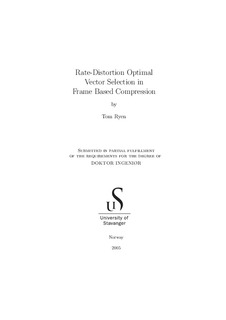Rate-distortion optimal vector selection in frame based compression
Doctoral thesis
Permanent lenke
http://hdl.handle.net/11250/249808Utgivelsesdato
2005Metadata
Vis full innførselSammendrag
In signal compression we distinguish between lossless and lossy compression. In lossless compression, the encoded signal is more bit efficient than the original signal and is exactly the same as the original one when decoded. In lossy compression, the encoded signal represents an approximation of the original signal, but it has less number of bits. In the latter situation, the major issue is to find the best possible rate-distortion (RD) tradeoff. The rate-distortion function (RDF) represents the theoretical lower bound of the distortion between the original and the reconstructed signal, subject to a given total bit rate for the compressed signal. This is with respect to any compression scheme. If the compression scheme is given, we can find its operational RDF (ORDF).
The main contribution of this dissertation is the presentation of a method that finds the operational rate-distortion optimal solution for an overcomplete signal decomposition. The idea of using overcomplete dictionaries, or frames, is to get a sparse representation of the signal. Traditionally, suboptimal algorithms, such as Matching Pursuit (MP), are used for this purpose. Given the frame and the Variable Length Codeword (VLC) table embedded in the entropy coder, the solution of the problem of establishing the best RD trade-off has a very high complexity. The proposed method reduces this complexity significantly by structuring the solution approach such that the dependent quantizer allocation problem reduces into an independent one. In addition, the use of a solution tree further reduces the complexity. It is important to note that this large reduction in complexity is achieved without sacrificing optimality. The optimal rate-distortion solution depends on the frame selection and the VLC table embedded in the entropy coder. Thus, frame design and VLC optimization is part of this work.
Extensive coding experiments are presented, where Gaussian AR(1) processes and various electrocardiogram (ECG) signals are used as input signals. The experiments demonstrate that the new approach outperforms Rate-Distortion Optimized (RDO) Matching Pursuit, previously proposed in [17], in the rate-distortion sense.
